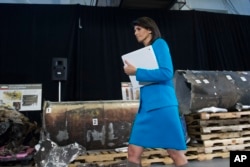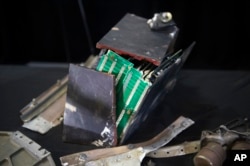To the Trump administration, the recovered missile fragments were incontrovertible proof that Iran was illicitly arming Yemen's Houthi rebels. Yet Iranian Foreign Minister Mohammad Javad Zarif is brushing it off as little more than cheese puffs.
During a visit to New York, the Iranian diplomat accused U.S. Ambassador to the United Nations Nikki Haley on Tuesday of displaying fabricated evidence that missiles lobbed by the Houthis at civilian areas in Saudi Arabia originated in Iran. Though Tehran supports the Shiite rebel group, it firmly denies giving them missiles. But Haley has invited journalists and U.N. Security Council diplomats to inspect missile parts recovered after strikes on Saudi Arabia, bearing what U.S. military officials said were Iranian markings and characteristics.
Zarif, in an Associated Press interview, said that one such logo was from the Standard Institute of Iran, which he said regulates consumer goods — not weapons.
"It's a sign of quality," Zarif said. "When people want to buy it, they look at whether it's been tested by the Standard Institute of Iran that your cheese puffs are good, your cheese puffs will not give you a stomach ache."
He laughed and added, "I mean, nobody will put the logo of the Standard Institute of Iran on a piece of missile."
The United States stood by its claims, pointing out that the evidence Haley presented went far beyond a single logo.
"The evidence in the Iranian Materiel Display is not fabricated," said Defense Department spokeswoman Laura Seal. She said the U.S. had shown the evidence to 65 countries, allowing the world to "assess the evidence for themselves."
But Zarif also pointed to a truck-size section of a missile that the U.S. said was recovered in Saudi Arabia and was transferred to a military base near Washington, where it was on display behind Haley for a photo-op. Zarif noted that the missile had been supposedly shot down in mid-air.
"I'm not saying Ambassador Haley is fabricating, but somebody is fabricating the evidence she is showing," Zarif said.
Some of the fragments Haley presented, if authentic, would implicate Iran's military industry more directly, including some with the logos of Shahid Bakeri Industrial Group and Shaheed Hemat Industries Group, Iranian defense entities under U.S. sanctions. Others had what Haley called ``Iranian missile fingerprints,'' such as short-range ballistic missiles that lacked large stabilizer fins — a feature she said only Iran's Qiam missiles have.
Haley's office responded to Zarif's comments by calling the evidence of illegal Iranian weapons shipments "overwhelming and beyond dispute."
"The fact that the Iranian regime insists on lying about that only highlights its lack of trustworthiness on every international agreement it is party to," the U.S. Mission to the U.N. said.
Tehran's denials aside, there's broad agreement among the United Nations, Western countries and the Persian Gulf's Arab leaders that Iran has armed the Houthis with ballistic missiles, even though U.N. Security Council resolutions prohibit it. With U.S. support, a Saudi-led coalition fighting in Yemen's civil war has been bombing the Houthis, who control the capital Sanaa and much of northern Yemen.
Yet Iran's opponents have struggled to provide foolproof evidence to back up their claims, creating an opening for Iran to deny.
After Haley's presentations at Joint Base Anacostia-Bolling, some national security experts raised questions, even drawing parallels to Secretary of State Colin Powell's 2003 speech to the U.N. making the case for the Iraq War.
The fragments Haley presented were turned over to the U.S. by Saudi Arabia and the United Arab Emirates — two of Iran's fiercest critics — and U.S. military officials had trouble tracing the fragments' chain of custody. Nor could they say when the weapons were transferred to the Houthis or, in some cases, precisely when they were launched.











